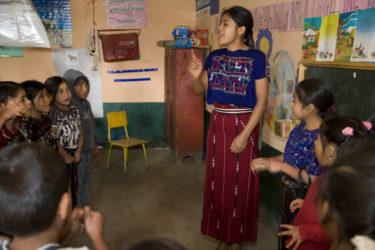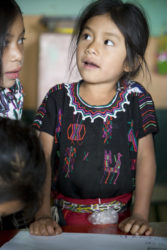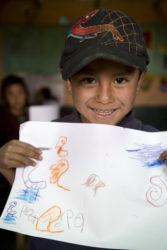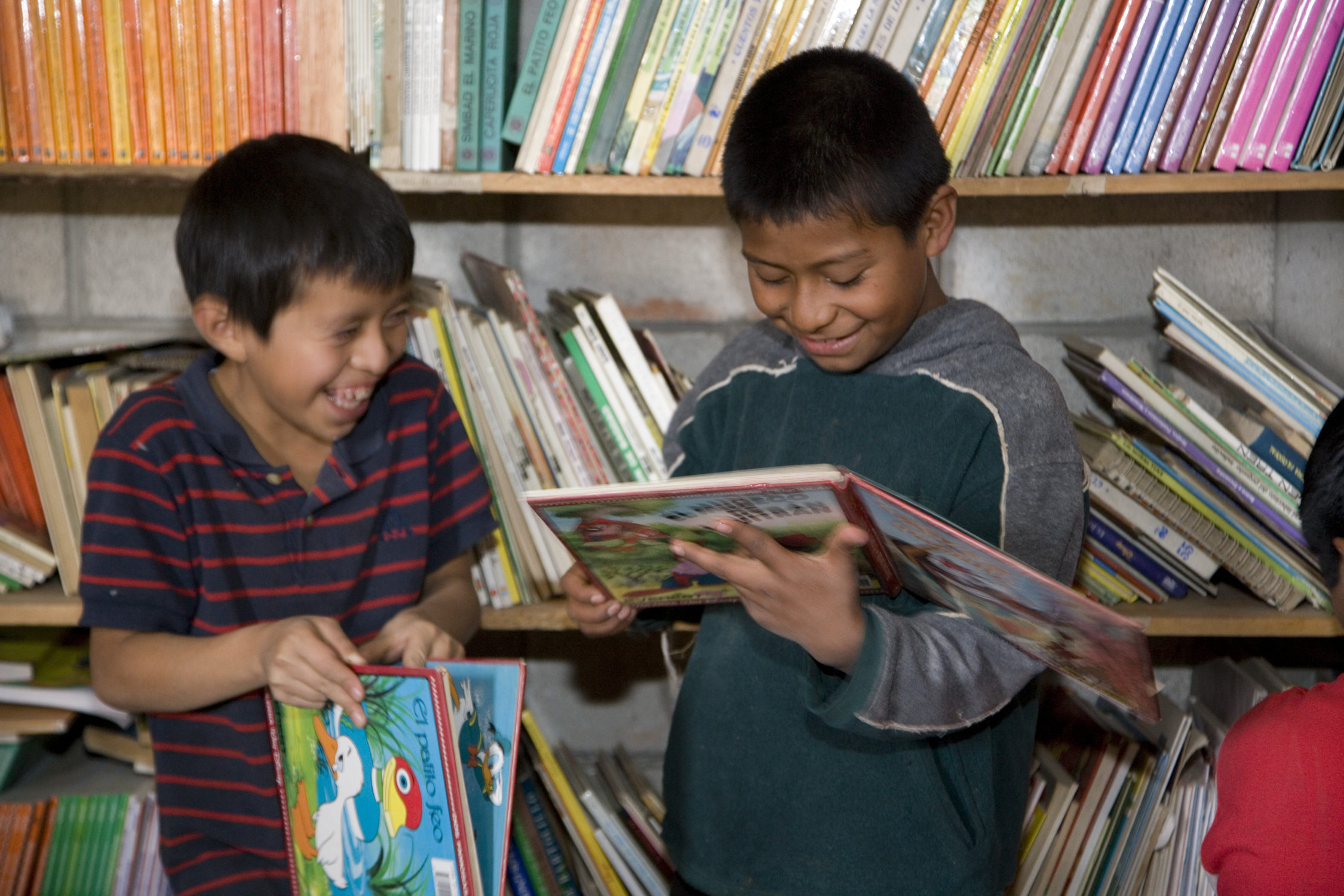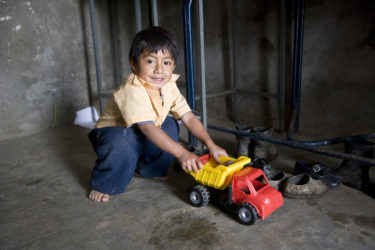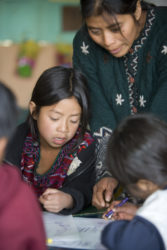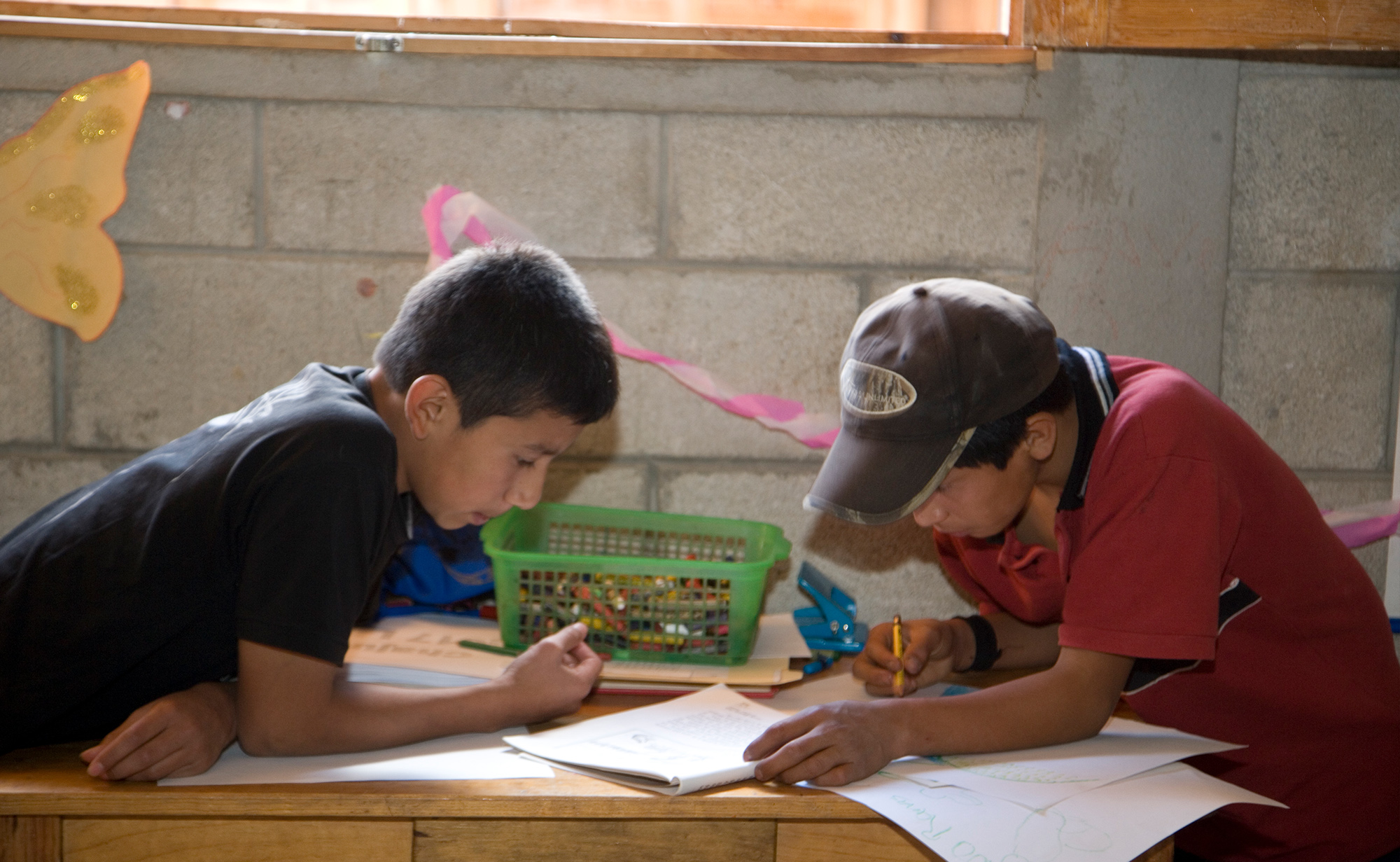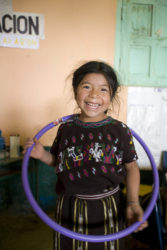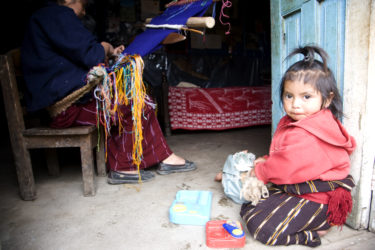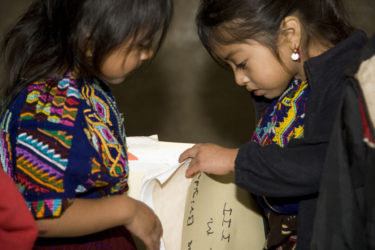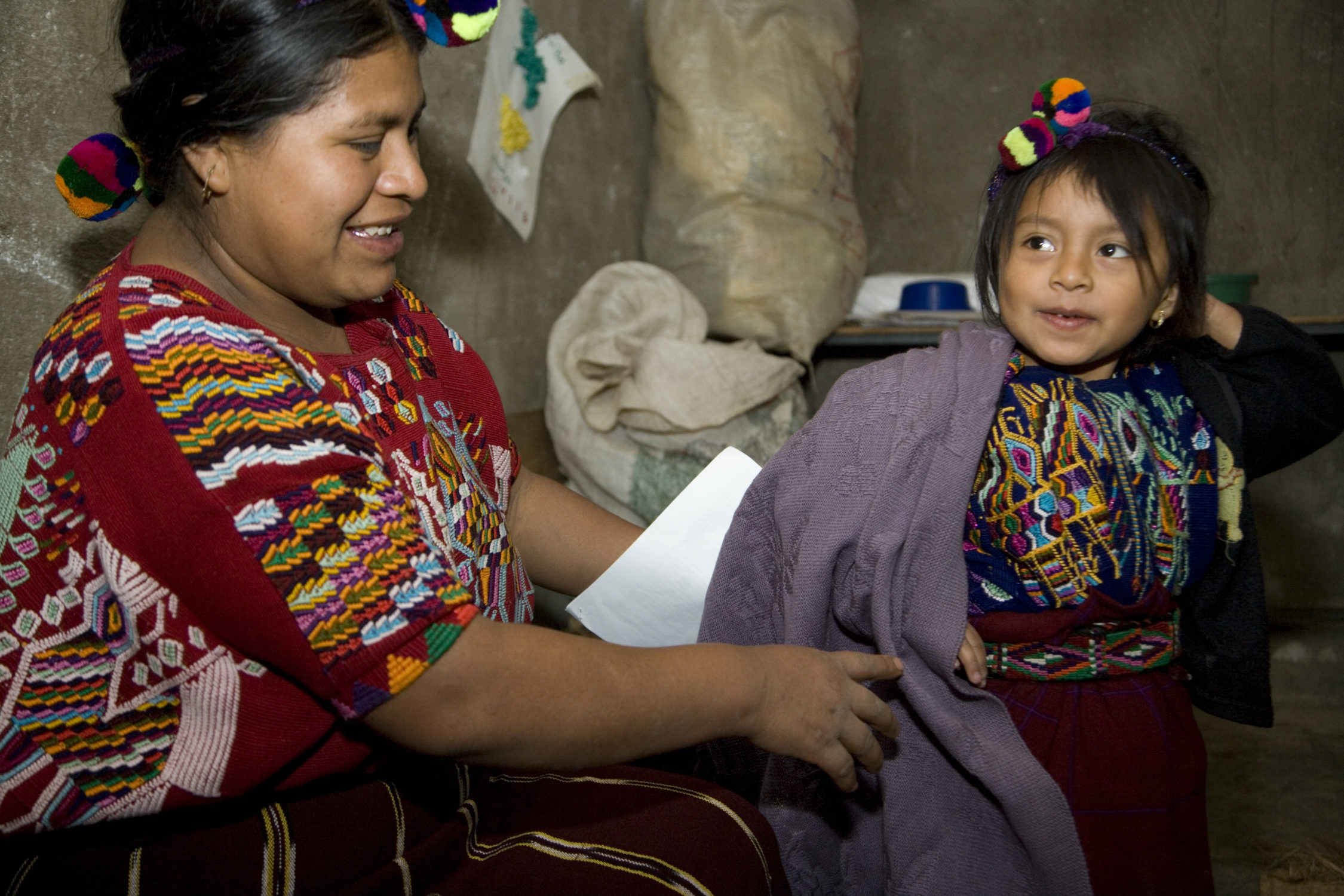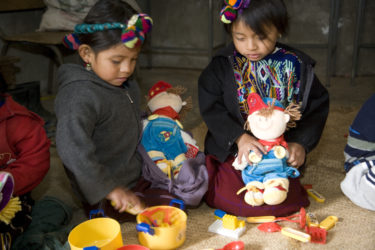Small but mighty
The incredible story of the women who made sure Guatemala’s educational system didn’t leave the nation’s indigenous children behind
Bernard van Leer Foundation Historical Cases
We commissioned narrative case studies of several countries in which we previously had a long-term presence. Though making the transition to scale was not then an explicit aim, we wanted to see what we could learn from these experiences to inform our scale-focused partnerships today.
Foreword
The question of which language should be taught in primary school is often fraught: while children ultimately need to learn a language that will enable them to communicate with a wide variety of people, hearing the language they speak at home in their first experiences of a formal learning environment can make all the difference to whether or not they ultimately succeed in school.
This case looks back at the Foundation’s funding for APPEDIBIMI (the Association for Holistic and Multidisciplinary Development) between 1990 and 2008, and its work to improve the prospects of children from highly marginalised indigenous communities in Guatemala through a child-centred, play-based pedagogy.
The case shows the lasting impact of the work of APPEDIBIMI, personified by the 40 publicly employed bilingual educators who were reaching approximately two thousand young children and who are still in post today – nearly a decade since the Foundation phased out its funding in the country. It also shows how the work of APPEDIBIMI was influential in the design of Guatemala’s post-war education reform, including legislation and the development of a national curriculum.
At the same time, it acknowledges some important limitations, with interviewees commenting that implementation of reforms stalled in part because there was no well-financed system in place to continue training teachers in the new methodologies.
I would like to thank Ms Sebastiana Ceto and Ms Magdalena Pérez for hosting Jean Friedman-Rudovsky, the author of this piece. It raised some interesting questions for me, which I share at the end. Thank you also to our programme officer at the time, Marc Mataheru, for his valuable guidance and recollections.
Michael Feigelson, Executive Director, Bernard van Leer Foundation, August 2018
Guatemala
- Period:1992-2008
- Total Bernard van Leer Foundation investment in Guatemala: EUR 3,000,000 – EUR 187,500/year
PART ONE
Margarita de Paz Pérez was born in 1974 in a small village in the Quiche Department, Guatemala, a highland region in the Cuchumatanes mountains to the north and west of the capital of this small Central American nation. The de Paz family belongs to the Ixil linguistic community, the largest indigenous group in Guatemala, who are direct descendants of the Maya and who, for the better part of their history, have remained largely isolated from Spanish influence.
When de Paz was around 6 years old, she started school in a one-room schoolhouse in her village. She remembers feeling excited and nervous on her first day, unsure of what to expect but eager for the new adventure. Things turned sour quickly. The teacher spoke differently from any other adults she knew. De Paz, along with most of her classmates, had no idea what the woman was saying. Unable to follow basic directions, de Paz said she was punished frequently, often with a swift slap on the hand with a ruler.
‘The teachers talked to us in Spanish,’ de Paz recalls, ‘which was hard because, at home, we only ever spoke Ixil.’ In those days, despite the fact that Guatemala’s various indigenous people comprised half of the population, teachers were mainly of mestizo (mixed) heritage, raised and educated in cities, and then assigned posts in the country’s rural areas without any training or preparation for the local customs, language or traditions they would encounter.
As children are prone to do, de Paz and her classmates learned quickly. By the end of the first year, she remembers being punished significantly less often. Her Spanish continued to improve as she made her way through the first years of primary school. It’s possible she could have gone further but her education was interrupted entirely in the early 1980s. Guatemala had been engulfed in a civil war since 1966 and when de Paz was reaching adolescence the fighting had reached her home, located in what was known as the ‘Ixil triangle’ – a term used by the military to describe the geographic triangle formed by three cities in Quiché Department and the home of primarily Ixil communities. Guatemala’s brutal leader at the time, Efraín Ríos Montt, targeted the group, calling them enemies of the state and an inferior race. Between 1982 and 1983, 70–90% of Ixil villages were razed. Close to 7000 Ixil people were killed during the war and 60% of the local population was displaced, among them the de Paz family.
The teachers talked to us in Spanish, which was hard because, at home, we only ever spoke Ixil. – Margarita de Paz
De Paz is a soft-spoken woman who, to this day, wears a mid-calf-length, tightly bound skirt made of red fabric and a woven blouse, the dress markers of the Ixil. She is back near her hometown in the Cuchumatanes mountains and when we met on a recent grey morning outside a one-room schoolhouse, de Paz told me she didn’t think much about those early years of her education until she was a young adult, in the 1990s. She and her family had migrated back to their home region and she heard that some local Ixil people, working with a French organisation known as Niños Refugiados del Mundo (NRM), were asking around her village for women who had had completed at least a few years of basic schooling. The organisation wanted to train local indigenous people to be educators for preschool-age children in their own community. De Paz volunteered.
Over the following eight years, de Paz and 40 other indigenous Ixil and K’iche people were trained to be bilingual early educators with a child-centred, play-based pedagogical approach. The effort was led by a group of Ixil who today comprise the organisation APPEDIBIMI, which stands for the Association for Holistic and Multidisciplinary Development. APPEDIBIMI also started two pre-kindergarten educational centres based on these models of child development. On the day de Paz and I met, I watched her lead a class of a dozen Ixil 4 and 5 year olds over the course of one morning. The lively group, dressed also in colorful woven cloth, played, sang, listened to stories and scampered about. When de Paz gave them instructions, she spoke in their shared native tongue; the part of the class during which she used Spanish was a call and response exercise that felt like a learning opportunity in and of itself. Throughout the morning, she would also initiate short, one-on-one casual conversations with her students in Spanish to encourage them to start using the language for conversation as well.
‘The first day, when I spoke to them in Spanish, they were totally silent,’ she said. ‘But as you can see, now when I do a call and response in Spanish, they all respond. They aren’t at 100% comprehension yet but they understand a lot.’ By the end of the school year, progress will be even more notable, she told me. Typically, by that point, she’ll overhear students conversing among themselves in their second language. De Paz and I spoke as her students played in the yard and eventually made their way home after the half-day’s lesson. The teacher soon excused herself as well, to clean up the classroom before she went home to carry out responsibilities there. As she said goodbye, Magdalena Pérez, the woman who had brought me here to meet de Paz, came over to say goodbye. The two chatted in Ixil and then hugged. They have known each other since the 1990s. Pérez and her colleague Sebastiana Ceto are two of the remaining group who first recruited and trained de Paz, and who continue to be involved in APPEDIBIMI. And it’s this group that was the local counterpart for the Bernard van Leer Foundation’s work with indigenous communities in Guatemala, beginning in 1990 and continuing until 2008 (though for the first decade the grant continued to be legally administered by the French children’s organisation, NRM).
Over the following days, I came to learn just how far APPEDIBIMI’s influence reached, packing a punch far more powerful than one would expect from an organisation that has only six staff and, at times, has worked with fewer. Pérez, Ceto and their colleagues played a pivotal role in Guatemala’s Educational Reform package, written after the war; they managed to include some of their cornerstone teaching techniques into the National Basic Curriculum, started a training programme for preschool and primary school teachers on their child-centred and bilingual educational methods. And they secured full-salaried teaching posts with the Ministry of Education for their original bilingual cohort of 40 teachers, including de Paz, as the nation’s first officially recognised bilingual teachers.
Their impressive impact came from a unique combination of humility, tenacity and a deep commitment to a set of principles – and, perhaps most importantly, from their strategic vision and the awareness that they needed to pursue more than one path to reach their end goals. ‘We have to remember that we didn’t just take one route to get where we are today,’ Pérez says. ‘We targeted the Ministry of Education, civil society and did the work in the communities all at the same time.’
Part Two
Magdalena Pérez, or Lena as she’s known to friends, has large, dark eyes and speaks swiftly and directly. In her current capacity as APPEDIBIMI’s Programme Coordinator and Pedagogical Specialist, she approaches her work with gravity and focus. Despite her no-nonsense demeanour, she consistently finds silver linings in the darkness, even when it concerns the hardest period of her nation’s recent history.
‘The civil war had its disadvantages but also its advantages,’ she told me one day as our car looped around the mountainous cliffs outside her current home town of Santa Maria Nebaj. ‘If there had been no armed conflict, all of these communities would have continued to live in isolation, without development, without modern means of communication, without interaction with others,’ she said, staring out the window at a group of small homes scattered on the hillside. ‘I remember what it was like then. Houses were far apart, and there were some areas where there were no schools and very few people understood the importance of education.’ The civil war, and the migration it forced, she said, pushed her fellow Ixil into a modernised world which, while not without a downside, at least meant that attending school was encouraged as a priority.
Another advantage, according to Pérez, was the way in which the war changed national policy with respect to the country’s indigenous population. During the 1980s, the government looked at Guatemala’s ethnic diversity as a problem to be solved, particularly when it came to education. Thousands of non-Spanish-speaking children were starting school unable to understand their teachers, which led not only to frustration in the classroom, but also to high early drop-out rates. (Families, particularly in rural areas, saw little value in their children spending their time at a place where they weren’t understanding anything or being productive.)
The civil war, and the migration it forced pushed my fellow Ixil into a modernised world which, while not without a downside, at least meant that attending school was encouraged as a priority. – Magdalena Pérez
The government’s solution, put forward around 1985, was Castellanización (castellano is a synonym for the Spanish language), which boiled down to an all-out campaign to increase Spanish literacy for everyone – from children to adults. ‘Unify the country with one language,’ Pérez says, explaining the concept behind it, ‘or, force Spanish on children so that everyone has a chance to learn.
But when the war ended in 1996 – by which time there had been what is now recognised as a period of ethnic genocide, particularly against the Ixil – the government was forced to do a 180-degree reversal. In a post-war climate, at least on the surface, cultural diversity was something to be valued and preserved, and millions of dollars in aid flowed in from abroad to support, feed, house, educate and bolster the well-being and preserve the traditions of the nation’s indigenous people.
In the area of education, APPEDIBIMI saw an opening. ‘We knew that Educational Reform was coming,’ says Sebastiana Ceto, APPEDIBIMI’s current director. The Peace Accords mandated a complete overhaul of the educational system. Ceto and her colleagues knew this would be an inclusive process with the participation of civil society groups. And they knew that part of what would be discussed was how to train teachers properly to work with bilingual children, their forte for almost a decade. ‘We had a head-start in that area with the work we’d been doing for years with educators,’ said Ceto.
We knew that Educational Reform was coming. – Sebastiana Ceto
At this point, APPEDIBIMI was still being supported by the NRM directly but it was the Bernard van Leer Foundation’s guidance that they said stood out and was especially appreciated. They started to plan and Pérez remembers telling the Foundation’s country representative, Marc Mataheru, of their idea, and being encouraged by him to take on this advocacy challenge. Mataheru counselled them that it would be worth the time and effort, and helped them strategise. Pérez remembers feeling as though it was a golden moment for their cause: ‘We realised that what our country needed were not temporary or transient measures, but something radical, something different, that could have the effect of producing change.’
PART THREE
Recognising an opportunity, however, and being able to take advantage of it effectively are not always one and the same.
The first hurdle that APPEDIBIMI had to overcome was ensuring their seat at the table for the Educational Reform conversation. To be considered for inclusion, according to guidelines, the group had to prove not only that they were a valid legal entity, but also that they were directly representing the interests of displaced people, and that they had expertise in the sphere of education.
To fulfil the first condition, some of the staff undertook the task of writing a history of the organisation. Others worked on the remaining demands: going from town to town in an effort to prove that every single community educator they had trained during the previous decade was indeed a displaced indigenous person. They held public meetings, collected signatures, tracked down birth certificates, and spent countless hours queuing to meet notaries. After several months of preparatory work, in late 1996, APPEDIBIMI was allowed to be part of the Educational Reform commission.
The commission’s work itself took two years. It wasn’t particularly hard to convince the group that there was a need to include bilingual education, but APPEDIBIMI needed to be present for the long, laborious process of working out exactly what form of words should be used in the package and what the priorities were among the diverse voices gathered. During that period, Pérez would, sometimes weekly, spend eight hours travelling from Nebaj to Guatemala City on winding, unpaved roads, often by crowded public bus. Then, after a day or two of meetings, she’d make the trip back.
The results culminated in strong language in the Educational Reform package: bilingual education is a cornerstone of the document, with emphasis on the need to make the nation’s teaching staff more diverse and able to carry out a culturally competent curriculum. The document reads:
Educational Reform requires a serious commitment on a national political level. Education should be considered of the highest priority for the state, and for municipal and central governments. Within this, there ought to be the strengthening of a national system for permanent training, and teaching colleges and programmes for the formation of bilingual teachers for the benefit of our linguistically diverse communities. Similarly, there should be supervision and evaluative mechanisms that guarantee the continued improvement of this system.
The results culminated in strong language in the Educational Reform package: bilingual education is a cornerstone of the document, with emphasis on the need to make the nation’s teaching staff more diverse and able to carry out a culturally competent curriculum.
The new National Basic Curriculum
After the completion of the commission’s work, APPEDIBIMI wasted no time in shifting their reform efforts towards the Ministry of Education. In addition to establishing a need for bilingual teachers, the newly drafted reform document laid the groundwork for a new National Curriculum and a training programme to deliver it, and APPEDIBIMI believed they had something valuable to contribute to both.
Their work had been known to the Ministry of Education for years. Carlota Calito de Alfaro, who works with the Ministry of Education (as Deputy Director, School-based Education), recalled being impressed by the preschool programmes that APPEDIBIMI was running in Nebaj, not only because of how well organised the school was but how they gave support to the teachers as they went along. So, starting in 2000, APPEDIBIMI was granted a slot as a secure regional representative to the group that would come to form the National Curriculum. At the beginning of this process, Ceto and Perez did a presentation for the Ministry of Education on their work in Nebaj. They demonstrated their bilingual curriculum component and the play-based pre-kindergarten model, in the hope that the government would like what they saw and want to implement it nationally.
‘We said to them, here is this great resource, we want to contribute APPEDIBIMI’s model to the nation and here’s what that looks like,’ Perez told me. The response was not what they’d hoped. Ministry officials had no interest in nationalising ‘the APPEDIBIMI way’ of doing things. ‘The Ministry said sure, you can do this – but only in the geographic area where you’ve already been working, and no further,’ said Perez.
Perez paused, and her face became slightly downcast. She said that at that moment they considered giving up the advocacy element of their work. They felt upset and hurt that their years of experience and efforts were shrugged off so easily. For advice they turned to the Bernard van Leer Foundation, who helped them do some self-reflection on their goals and priorities. ‘The Foundation encouraged us to ask ourselves: what do we want – credit, or to insert our experience into the curriculum?’ said Perez. They decided it was the latter. ‘We accepted losing all credit for our work entirely,’ she said. They thus positioned themselves to the Ministry as an organisation that was there to be of support, without needing anything in return. Their strategy paid off. They stayed on in the working group, which lasted over seven years, and eventually the National Basic Curriculum ended up incorporating several elements of the APPEDIBIMI model.
Following this, APPEDIBIMI swallowed their pride one last time. In 2008, when the curriculum had been finalised, the Ministry of Education started looking for civil society organisations with staff who could be trained in the new approaches, and would then train teachers around the country in how to use the new CNB (National Basic Curriculum), as it’s known. But given the fact that so much of APPEDIBIMI’s model had ended up in the national document, if APPEDIBIMI accepted being on this government training team, it would essentially mean that they would allow the Ministry to train them in their own teaching methods – a huge and bitter pill to swallow.
Ceto gives a slightly pained smile at the memory and said they wrestled with the decision, talking again with the Bernard van Leer Foundation about it. ‘Marc told us: you can do this, it’s the right thing to do,’ recalls Ceto. ‘So, we went to the Ministry of Education so that they could train us in our own model and then carry that experience to teachers in our area.’ APPEDIBIMI was the primary link with the Ministry of Education for teacher training, especially at preschool level.
Despite the government not wanting to put APPEDIBIMI’s name on the parts of the national model that originated with the group, they do recognise the exemplary work the organisation has been doing for decades.
‘APPEDIBIMI had so much success in part because of their honour, and also because of their unique early childhood development model that utilises play, humility and finds a way to address the bilingual component too,’ the Ministry of Education’s Calito said to me. ‘They started by training community leaders, and there is great wisdom in this ground-level experience. Since primary and higher levels of education had no way of capitalising on community educators, it made a lot of sense to put them to work in early childhood education.’
I asked Calito whether the relationship between the Ministry of Education and APPEDIBIMI was typical, similar to ordinary relationships between the government and other NGOs, or something special. ‘This is very special,’ she answered immediately. ‘There is a friendship and a closeness here that I have not seen with other NGOs. The relationship with others is normally purely administrative, on paper only. Or we will work closely with a group for a while and then they disappear. APPEDIBIMI has never disappeared.’
PART FOUR
For her first few years in the classroom, preschool teacher Emma Chaperón had her own way of doing things, which followed what she was taught at teacher training college. Each subject was given a set time-period during the week in the lesson plan and she stuck to a strict, predetermined schedule for almost everything. In practice, her days involved writing on blackboards and struggling to get 4 and 5 year olds to sit still for long periods of time.
Then, in 2010, she was offered a chance to be part of a training programme through the Ministry of Education. For over a year, she joined 35 other colleagues from her region every two months to learn how to teach differently. The focus of the new methods was on play and strategies for getting children to participate in their own learning. She was taught how to be interdisciplinary in her lesson planning; how to use arts and crafts activities, for example; to give a maths, science and reading lesson all in one.
‘It was quite a lovely experience,’ Chaperón told me when we met earlier this year on a rainy afternoon in Santa Cruz de Quiche. ‘It was very different from any other professional training we had ever received.’
The training also helped her make sense of several elements that were in the preschool CNB, which she was supposed to have been following but hadn’t yet implemented in the classroom because it was all a little fuzzy to her. For example, there was an attendance sheet poster and values chart on which the students themselves were responsible for marking themselves in every day and for evaluating their own behaviour daily. She had never grasped why it was important, but through the training she realised that these small things stimulated a child’s ability to understand their relationship to a group, and peers, and to begin to take responsibility for their own actions and how they affect others. This formed part of the learning of values and citizenship in children at the earliest age.
The rincones de aprendizaje (learning corners), was a new approach in which different areas of the classroom are designated for different kinds of tactile, craft-based, musical or science-based activities.
Similarly, she learned how to do the rincones de aprendizaje (learning corners), an approach in which different areas of the classroom are designated for different kinds of tactile, craft-based, musical or science-based activities. She hadn’t started this in her classroom because no one had given her the materials to use in these corners. The trainers, however, showed her and her cohort how they could use found objects – bottle caps, stones, sticks, sand and other natural elements – to supply a large part of each play area. ‘I learned that practically anything I had on hand could be a learning tool,’ Chaperón said.
When she had questions about how things worked in practice, she was able to ask the experts: teachers who had been using these pedagogical techniques in the classroom for years. The training group made field trips to meet these experienced teachers; she could see the techniques in practice, which she said was immensely helpful. She also learned how to train others, so she has spread the model to dozens in her region as well.
Chaperón looked at Pérez, who had been coming in and out for parts of our interview, and smiled. Chaperón had recently given birth; her baby of 3 weeks was at home but she had wanted to recount her experiences so much that she came out to meet me.
Pérez had asked Chaperón if she’d speak with me, so that I could hear how it felt to use these methods and how they were enacted on the ground – the difference they made in the lives of teachers and their students. Despite the emphasis on advocacy, APPEDIBIMI has consistently maintained the drive to improve the skills of teachers in the classroom and to advance the potential of those with bilingual expertise in the community.
Another way in which this was carried out was by campaigning to get their original 40 Ixil community educators recognised as full teachers. APPEDIBIMI started down this path soon after the war ended. They knew that the state would enshrine the right to bilingual education in law, and that this would include mention of the state needing to open posts for bilingual teachers who knew how to run classes in two languages. Why shouldn’t APPEDIBIMI’s 40 original educators – who already had exactly these qualifications – be the state’s first bilingual education appointees?
These educators were already on the state payroll – but not as teachers. An agreement with the Ministry of Education in 1999 had given them government contracts and salaries under the title of ‘secretaries’, because the government had refused to open new teacher slots to accommodate them. APPEDIBIMI accepted this in the interim, but now was the time to make them actual teachers in name too.
In 2008, they finally achieved their goal. ‘Every one of our teachers was allowed to stay in their own community, continuing to teach in their own educational centre’
– Magadalena Pérez
And they didn’t just want teaching posts. ‘We believed that our teachers should be given placements in the communities where they were living, where they were connected to the community, and not relocated to wherever there were openings,’ said Ceto, referring to the custom in Guatemala’s educational system under which once you’re a government teacher, you are expected to fill any vacancy in any part of the country regardless of your cultural connection. This, says Ceto, was perhaps the hardest bureaucratic push that the organisation had had to make in its entire history. It involved frequent journeys to Guatemala City, leaving the mountains at 2 a.m. to arrive for an 8 a.m. meeting and then coming back home that same day; piles of paperwork and years of foot-dragging over the course of six years. In 2008, they finally achieved their goal. ‘Every one of our teachers was allowed to stay in their own community, continuing to teach in their own educational centre,’ Perez said.
Over the course of my visit, Perez told me several times that this was the achievement she was most proud of. At first it seemed like a curious statement. From an outsider’s perspective, it looked like a perhaps trivial realignment of resources from administrative posts to educational posts within the Ministry of Education. But, says Bayron Villatoro, a teacher who works as a CTA (government teacher support coordinator) in the Quiche Department, this agreement forced the government to live up to its own promises: it got them to enact a commitment that they had made on paper, which sometimes feels all but impossible in poorer nations. Making these ‘secretaries’ into teachers and keeping them in the communities where they are connected, effectively meant the establishment of the state’s first bilingual educational centres. And, he said, it meant that the government was taking responsibility for carrying out this work, rather than leaving it to the whim of international donors. ‘It is very important that my Ministry of Education acknowledges its commitment to supporting and establishing bilingual educational centres,’ Villatoro told me. ‘This guarantees continuity, because international financing is inherently temporary.’
PART FIVE
On a sunny afternoon, Manuel Ixcoy, 25, held up paper cut-outs of the upper respiratory system in an expansive meeting room, and taped them on his chest. As he leaned back slightly to make sure they stayed in place, he asked Pérez and Juana Rivera to repeat after him: ‘luuuunnngg,’ he says slowly in Spanish. Rivera and Pérez repeat. ‘Traaaacheeeeaaaa,’ he continues, moving his finger to the corresponding organ. They respond accordingly. After going through all the notable body parts still stuck to his shirt, he passes out blank pieces of paper, puts a set of worn crayons in the middle of the table between the women, and instructs them in Ixil to colour what they see on his chest, and to ask him any questions if they are confused. The women diligently scribble crude drawings, staying in character as young primary school students, occasionally asking for assistance or clarity, as one might expect actual students to do.
A few moments later, it’s Rivera’s turn to practise as teacher and she asks the group in Ixil what they are in the mood for: to continue doing something inside or to go outside for a while. Perez and Ixcoy vote for the latter and Rivera as teacher leads them to the concrete inner courtyard of the APPEDIBIMI offices in Santa Maria Nebaj. She instructs them to find bits of flora – grass coming through the cracks in the paving, leaves that have fallen from trees above, or small parts of the large potted plants placed around the facility. After a few minutes of scavenging, she calls them in and they discuss the tactile and ecological differences of what they’ve gathered, before putting together a piece of artwork with the found materials. Ixcoy and Perez follow along, but with some interruptions and a peppering of random thoughts that are likely to come from a 7 year old doing this same exercise. Rivera responds in a calm voice, sometimes using Spanish, sometimes Ixil, delicately balancing the desire to keep the lesson moving along but allowing it to go off at a tangent according to where the interests of the ‘students’ seem to lie.
The practice lesson lasts for more than an hour before everyone is allowed to come out of character and return into the meeting room to discuss how it all went. Ixcoy and Rivera are part of a new team at APPEDIBIMI, supported by the Pestalozzi Foundation from Switzerland, to expand the child-centred curriculum beyond the pre-kindergarten work that they’ve done for decades, to primary schools. It’s a two-year programme that started only recently, in which field trainers offer professional development to first-, second- and third-grade teachers through five training sessions in the core APPEDIBIMI bilingual, child-play model, and then afterwards through monthly follow-up workshops and monitoring in the classrooms. They do regular practice sessions like these in the office to hone their own skills in being able to lead workshops, and to reinforce those same skills among the teachers they work with in the region.
Ixcoy, Rivera and two others each have 20 teachers under their wing. What Ceto and Pérez have found is that changing practice must go much further than simply teaching a new way of doing things. It requires continuing support and training and so the job of the four field trainers is to reinforce the model and be there for those who are serious about changing the way they operate their classrooms.
Each month, the field trainers sit in on one classroom session to observe, so that the trainer can provide individualised feedback. Rivera admits that at first the teachers feel a little intimidated by her presence, but that they quickly learn that she’s not there to criticise or supervise, but to offer support. ‘At the end of the first session they always feel better,’ Rivera told me. ‘The majority say, you’re right, this was needed because I wasn’t quite sure of what I was doing and your suggestions and clarifications were helpful.’
After the classroom visits, the field trainers and teachers gather in monthly two-hour ‘interactive circles’ during which teachers can talk about their experiences, ask questions, and do some peer support for implementing their new model. The emphasis is on shared learning. Ixcoy says that they begin these sessions by working on issues they have been able to pinpoint as common difficulties across the classrooms, and then they evolve organically among the group.
I had seen one of these teachers in action a few days prior to seeing the APPEDIBIMI technical training. I watched as Ana María Cruz, a teacher for over 15 years, led her class in a call and response exercise about natural resources. ‘What are some natural resources around us?’ she asked her group of 7 and 8 year olds. ‘Water! Streams! Rocks! The ground!’ and more, they shouted back at her. During the mid-morning break, I asked Cruz how this lesson would have been different had I come to her class before she had gone through the APPEDIBIMI training. ‘You would have seen me writing a list of natural resources on the board and telling them to copy it into their notebooks,’ she said.
‘Children were afraid. We don’t want them to be afraid in school! Now with this model, the child is an active builder of their own learning, and that’s what we all want, right?’ – Ana María Cruz
She said the reason why she had stuck with the new way of doing things was because of how well her students had responded to it. ‘My kids used to be completely quiet because they were not used to participating at all in their own learning,’ she said. ‘They were afraid. We don’t want them to be afraid in school! Now with this model, the child is an active builder of their own learning, and that’s what we all want, right?’
Another thing that changed was the language component. Even though Cruz speaks Ixil, she had never used it in the classroom before – in part because parents did not approve. ‘What parents would say to us is “We speak Ixil at home so in school my child should only be learning and talking in Spanish”,’ Cruz said. There were other complaints from parents too, including questions like: ‘Why doesn’t my child have homework anymore?’ and ‘Why isn’t his notebook filled with lessons?’.
Cruz says that she, along with APPEDIBIMI staff, held parent meetings to explain the new approach and calm nerves. ‘I told them: please let us try out this new way of teaching. Let us work and I promise you’ll see good results.’ The parents were reluctant at first, she said, and some are still sceptical, but most have come around.
Ixcoy told me that parent push-back is very common, and it’s one of the reasons why they build parent meetings at the school and home visits into their work flow. ‘I remember one set of parents who had gone to the principal to complain about their child not having homework or pages and pages of copied notes,’ Ixcoy told me. The father was furious, convinced that the teachers were slacking and that his child wasn’t being taught anything. Ixcoy recalls replying along the lines of: ‘Sir, I understand your worry, but please be patient. We are trying out a new way of teaching. Your child could have a lot of things written in his notebook, and yes that means he can read and write, but it doesn’t show anything more than that. If there aren’t activities in the classroom in which your child can compare things and analyse things then he is not getting any mental exercise. Children learn as they do things – drawing, playing, interacting with others – and that’s what we’re doing.’ Given these challenges, and given that the new method requires more planning and effort on the part of the teacher, Cruz estimates that about half of the teachers being trained in her school are implementing it in the classroom.
I asked Ceto and Pérez why they decided to try to launch this programme in primary schools when they could have kept their attention on pre-kindergarten. Ceto explained that USAID commissioned a study in 2008 to look at where students of their bilingual early education centres ended up later on in life. They found that not a single one had failed a grade in their advancement through primary and often high school.
USAID commissioned a study in 2008 to look at where students of their bilingual early education centres ended up later on in life. They found that not a single one had failed a grade in their advancement through primary and often high school.
But, she says, there was a testimony from one boy that shook her: ‘He said that when he got to primary school it was like a rude awakening. The teaching style was so different. He had been used to active classrooms, the rincones de aprendizaje, and to being happy in the classroom. All that ended when he got to primary school and was forced to just memorise and copy things into his notebook.’
Ceto said to me: ‘I’ll never forget that,’ and it’s what catalysed their decision to try to keep their model going for longer in the educational experience of some children, if possible. The government itself has almost no capacity for professional support or development and so the Ministry of Education was happy to accept the proposal, which is now being carried out throughout the Nebaj region. The programme only has experience of two years at primary school level, and funding from the Swiss Pestalozzi Foundation; Ceto and Perez hope to be able to extend this to six years, because they believe that’s how long it takes to cement change into the practice of teachers with already established habits. This because it is a slow process to adopt innovative teaching methodologies and to create the capacity for them on a permanent basis.
Back in the APPEDIBIMI office, after the rehearsal is complete, Pérez and two of her team do a thorough self-evaluation of what they just went through. Perez tells them they needed to be more adaptable to the preferences of the ‘children’ during the exercise, giving them more options to choose from in what they wanted to do. They also could have done more in Ixil. Rivera and Ixcoy take notes as Perez talks. Then Perez asks them how things are going in the interactive circles, where there are areas of weakness. Rivera and Ixcoy say that things are going well: they sense enthusiasm and interest. They say where they are struggling: there is trouble integrating certain areas into their more dynamic lessons, particularly in maths and reading. Perez nods and offers a quick response: ‘OK, then we know what we have to work on. We’ve got to improve our help for teachers in combining maths and reading comprehension with playful activities.’
PART SIX
Back in the Cuchumatanes mountains, on the morning when we visited de Paz and her classroom, I asked Perez how it felt to be there, with one of the women who helped start all this. Perez admitted she felt a little sentimental about it: ‘We don’t get the chance these days to reflect and observe on a daily basis anymore. So, when you return and see a teacher [like de Paz] who still finds her work enchanting and meaningful and continues doing it with passion, simply because it makes her students’ lives better, that’s really something,’ she said. It reminded her, she continued, that they are ‘very, very proud of the work we did here, that we had such a strong experience with preschool education and that we then got to be part of the creation of the CNB and of its training and implementation programme.’
Though a lot has been cemented in law, as in many developing countries there is almost no real budget for the implementation of progressive policies.
She and Ceto have worries. Though a lot has been cemented in law, as in many developing countries there is almost no real budget for the implementation of progressive policies. After the initial training that they and others carried out for the CNB in pre-kindergarten schools, there is no monitoring or support programme for teachers wanting to implement the enlightened curriculum. The country still does not invest particularly strongly in early education, and has almost no recognition of the need to provide attention to children from birth to the age of 3. There is also no teaching college for bilingual teachers, even though the Education Reform package says that the state should be doing this by law.
The funding question also hits home for their own organisation. They have managed to attract other international donors but fundraising is a constant task and it means that they direct less attention to other work while they take time to seek donations. Ceto says that their continued reliance on international aid is, in and of itself, a reflection of the fact that they haven’t yet accomplished their goal. ‘If we are still dependent on international aid it’s because we haven’t fully done our job of cementing the need for early childhood education in our countries.’
They also worry about how modernisation will affect the cultural element of the educational system. Ceto said: ‘During one of my classroom visits, I spoke with a teacher in the Ixil area who had been trained to use the new curriculum and should have been implementing the bilingual programme. I asked her if she was speaking Ixil at all with her students. She said no, because it wasn’t necessary. All her kids had started the year already knowing Spanish.’ Perez told me later how much that comment bothered her: ‘It’s still important,’ she said, ‘this is about respect for diversity and strengthening culture. Just because [an indigenous] child has had an opportunity to learn Spanish at home it doesn’t mean that Spanish should be the only thing spoken from there on out. That puts us on a path to lose something very valuable. When a child stops talking their native language or never learns to write in it, then the child is on track to lose their customs, which means slowly the country could lose them as well.’
Their dream would be to have the chance to work with a cohort of children from birth, through completion of high school. ‘If they said to us, here are five schools where you could start with kids, even mothers in the prenatal stage, and then continue up through all levels of learning, that would be like the ultimate goal,’ Ceto told me. They could track outcomes for the students, she said, ‘and then demonstrate to the Ministry of Education the importance of early education and of continuance. Because those kids would never forget what they learned over the years.’
On my last day in Guatemala, I asked Ceto and Perez to reflect on what the Bernard van Leer Foundation brought to the equation for them. Perez took a moment to think and then offered this: ‘I value van Leer a great amount. First, their faith in us and support to us in the immediate post-war context – the ways they helped us think bigger, more politically. Second, it was Marc [Mataheru]. As a person, he was greatly interested in bringing about change in this country. And he was interested in how we wanted to do that, in our vision. With van Leer, it wasn’t just about their financial investment in us. It was about the experience of working with them and how they valued us as people. We have worked with other donors who say no to what we want to do, or who tell us what they want and expect us to carry that out. Mataheru and the Foundation were always there with an open mind, constructive thoughts, helping us to strengthen and consolidate our organisation and our experience. We almost gave up when we realised we had to give up the credit for our work when we brought it to the government. We felt defeated and all our experience and knowledge was about to be buried, as if in a coffin. But van Leer saw how, if we were flexible, this could still go places. And that’s what happened.’
Learning Questions
We commissioned these historical studies in part to identify questions we should ask ourselves as we plan future work. Learning questions raised for us by this story include:
- How should a foundation counsel a local partner whose work is influencing policy behind the scenes but without getting the public acknowledgement they feel they deserve? Do you agree with the way in which the Foundation provided counsel in this case?
- What might the Foundation have done differently during its time working in Guatemala to address the challenge of scale and sustainability? What role might it have played in building a system that could provide ongoing training to teachers in the country?
- What kind of research might the Foundation have done during the years working in Guatemala to better document and understand its successes and failures?
Copyright © Bernard van Leer Foundation. All rights reserved.


